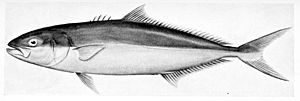Yellowtail amberjack facts for kids
Quick facts for kids Yellowtail amberjack |
|
|---|---|
 |
|
| Conservation status | |
| Scientific classification | |
| Synonyms | |
|
The yellowtail amberjack, yellowtail kingfish or great amberjack (Seriola lalandi) is a large fish found in the Southern Ocean. Although previously thought to be found in all oceans and seas, recent genetic analysis restricts S. lalandi proper to the Southern Hemisphere waters. However, they are found in northern hemisphere waters during certain times of the year. The fish was given its name by Monsieur de Lalande, a naturalist who first informed Valenciennes of the existence of this species. No one is sure why he used the word Seriola (feminine diminutive form of seria, a large earthenware pot) to name the fish, but the second word lalandi was derived from his surname Lalande.
Taxonomy
The yellowtail amberjack was formally described in 1833 by the French zoologist Achille Valenciennes (1794–1865) from type specimens sent to il by the naturalist and explorer Pierre Antoine Delalande (1787–1823), who is honoured in its specific name. Fishbase includes populations of similar fish in the Northern Hemisphere within this species but other authorities regard Seriola aureovittata from the North Pacific Ocean around Japan and Seriola dorsalis of the north eastern Pacific as separate species.
Distribution and habitat
The yellowtail amberjack occurs in tropical and temperate waters of the southern hemisphere and the northern Pacific. In Australia, it is recorded from North Reef, Queensland (23° 11′ S) to Trigg Island, Western Australia (31° 52′ S), and as far south as Tasmania.
The yellowtail amberjack (or yellowtail kingfish as it is known in Australia) is a pelagic, schooling fish, usually seen as adults in small to large numbers. In general, they inhabit rocky reefs and adjacent sandy areas in coastal waters and occasionally enter estuaries. They are found from shallow water down to depths of around 50 m, although have been caught from over 300 m.
Young fish up to 7 kg are known to form shoals of several hundred fish. They are generally found close to the coast, while larger fish are more common around deep reefs and offshore islands.
Juvenile yellowtail amberjack are rarely seen, as they are often found far from land associated with floating debris or weed which provide camouflage. Juveniles are yellow with black bands. This colouration fades as the fish ages and by about 30 cm in length, the fish has assumed its adult colouration.
Biology
Very little is known of the yellowtail amberjack's biology, including their habitat preferences throughout juvenile life stages, migration patterns, and wild reproductive behaviour. Adults live around rocky reefs, rocky outcrops and drop-offs in coastal waters, and around pinnacles and offshore islands. Maximum length is often reported to reach up to 180 cm.
Sydney Harbour
Before the introduction of kingfish traps (for commercial fishing) in the 1970s, there was a huge amount of yellowtail amberjack in Sydney Harbour. These traps were so effective that some studies suggested the traps may have wiped out as much as 60 per cent of the larger amberjack population. In the mid-1990s under heavy pressure from recreational anglers, Bob Martin the Minister for Fisheries prohibited the use of these traps in Sydney Harbour.
Uses and aquaculture
Seriola lalandi has been established as a suitable candidate for marine aquaculture. In contrast to the culture of the Japanese amberjack (S. quinqueradiata), which has long been cultured extensively in Japan, juveniles of S. lalandi are not easily available from the wild, and juveniles are produced in hatcheries from captive breeding stock. In 2010, the Stehr Group in South Australia was the largest producer of cultured S. lalandi in the world. Trials elsewhere in Australia have been undertaken and in some cases abandoned after stock losses. Water quality concerns were raised following farmed kingfish mortalities in upper Spencer Gulf, South Australia in 2011. In the late 2010s, yellowtail kingfish farms were established near Geraldton and the Abrolhos Islands in Western Australia by Indian Ocean Fresh Australia and Huon Aquaculture respectively.
Some attempts have been made to culture the species in New Zealand, both in sea cages and a large land-based system at Parengarenga Harbour (northern New Zealand). Chile is currently trialling seacage and land-based farming methods. In Germany S. lalandi is being cultivated in the first land-based seafish-culture. The Dutch company, The Kingfish Company, is planning to open a land-based aquaculture S. lalandi operation in Maine, U.S., in 2022. Most cultured S. lalandi is sold to the Japanese restaurant market for consumption as sashimi. Amberjack can be eaten in a variety of ways, including grilling and drying.
See also
 In Spanish: Jurel de Castilla para niños
In Spanish: Jurel de Castilla para niños


